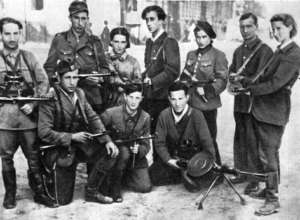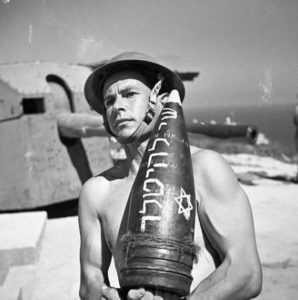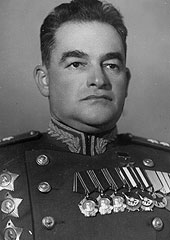Last week was International Holocaust Remembrance Day. Established by the U.N. for January 27, on the anniversary of the liberation of Auschwitz by the Soviet army. And as every year, we will hear the speeches, we will remember the 6 million innocent Jewish victims, and the 5 million additional minority victims, and we will honor our dead.
But this year, I’d like to say something a little different. We talk a lot about remembering the victims, and rightly so. But we also hear a lot of “but why didn’t they fight?” and “why didn’t they try to escape?” The “passive victimhood” myth of the “weak” Jew. And so this year, I choose to remember that “they” did.
Historians estimate that 1/3 of the entire (100,000 strong) population of the Minsk ghetto attempted an escape. At least 1/3 of them actually succeeded, with most joining the partisans in the forests. Eastern European Jewry’s family histories are full of teenagers who found ways to run, who jumped off moving trains, who were pushed into bushes and ditches by their parents, and managed to run, to survive. Thousands of young Jews staged a massive uprising in the Warsaw ghetto, holding the ghetto alone, without support, for an entire month against the German troops. More than 2,000 Jews participated in the Slovak revolt, including underground fighters from 3 Jewish labor camps, holding Slovakia for 2 solid months in 1944.

Members of the Fareynikte Partizaner Organizatsye, or the United Partisan Organization in Vilna.
Even in the death camps themselves, the ultimate symbol of the “helpless victims led to the slaughter,” the prisoner uprising at Sobibor extermination camp, orchestrated by over 600 prisoners and led by Soviet Jewish POW Alexander Pechersky, was so successful that the Nazis demolished the camp, planted it over with pine trees, and tried to pretend it never existed. 700 Jews staged an armed uprising in Treblinka in 1943, stealing rifles and grenades from the Nazi troops, and setting sections of the camp ablaze. And hundreds of prisoners revolted in Auschwitz in 1944, blowing up one of the crematoria and taking up hammers and rocks to kill their jailers, after 4 Jewish women had smuggled gunpowder on their bodies for months for explosives. In addition, an estimated 20,000-50,000 Jews served in the partisan fighter units in the forests of Eastern Europe – at least 4,000 of them serving in explicitly-Jewish partisan units.
Furthermore, let’s not forget that over 1.5 Million Jews took up arms under the official military banner against the Nazi threat. Half a million of them in the American army alone – more than 1 in 10 Jews alive in the United States at the time. Among them, Major-General Maurice Rose, commander of the 3rd Armored Division, the first American tank unit to enter Germany, who lost his life to 14 German bullets in 1945 – having gotten his tank column within 200 miles of Berlin.

Joseph Wald, a Jewish Brigade soldier, carries an artillery shell. The Hebrew inscription on the shell translates as “A gift to Hitler.”
An additional 100,000 Jews served in the Polish army – a full 10% of all Polish soldiers – with 1/3 of them giving their lives to the effort to defend Poland and its Jewry – over 10,000 of them falling in defense of Warsaw alone. Another 30,000 Jews from the Jewish Yeshuv that later became the State of Israel volunteered to serve as part of the British army. And an additional 5,000 soldiers from the pre-State of Israel Yeshuv served under the auspices of an independent Jewish fighting force – the Jewish Brigade Group, fighting under the Zionist flag – the first Jewish military unit in 1,800 years to be publicly recognized as representing the Jewish people.
And less well known in the West, let’s not forget that another half a million Jews – including 20,000 Jewish women – took up arms under the official military banner of the USSR, helping liberate Belarus, Ukraine, Poland, Lithuania, and much of Germany, including Berlin itself – the very lands where the vast majority of Holocaust deaths occurred. This is the army that actually liberated the majority of the death camps – and each one – Auschwitz, Terezin, Majdanek, and more – had armed Jewish soldiers among the liberators. 40% of these Jews gave their lives in the process – dying at far higher rates than the roughly 25% death rate of the Soviet army overall. My own great-uncle, Vladimir Margulis, gave his life liberating Warsaw, having already lost his father to the battles. The Soviet army that took Berlin included around 300 Jewish generals and admirals, and over

Vladimir Kolpakchi
165,000 Jewish military officers, including Lieutenant-General Vladimir Kolpakchi, commanding the 69th Field Army that helped take Berlin itself. Over 35,000 Jews received official Soviet military commendation for their service in the war, and over 150 received the title of “Hero of the Soviet Union” – the highest honor available in the USSR. Among them was the rare double-recipient, tank commander David Dragunsky, whose tank brigade was instrumental in the battle for Berlin. While Dragunsky, who was wounded 5 times, was off at war, his entire family was murdered by German troops back home – including his parents, his grandparents, his 2 sisters, and 3 young nieces and nephews.
Today, most of the surviving Soviet Jewish veterans – only a few thousand remain – live in Israel, having made aliyah to the Jewish state in their later years. And every year, on Victory Day in May, they parade down the streets of Israeli cities, wearing their old uniforms and covered with medals – often supported by grandchildren and great-grandchildren now in IDF uniform. And I would dare anyone to look them in the face, to see their chests dripping with medals – and tell them that “the Jews didn’t fight.”
So when we hear “why didn’t they fight,” let’s just remember – yes, few of the victims were ever given the chance. But for all the ones that could – they sure as hell did fight.
So this week, and on all days, I will, naturally, say “We Remember”.
And I will also say, “We Are Thankful”.




Jenna,
Thank you for writing this article.
Jewish Americans need to stop denying and finally learn about the Forgotten (hidden?) Holocaust. Our Holocaust, where a quarter to a third of the six million perished.
I am also thankful to Yahad In Unum and Father Desbois, a French Jesuit priest, for documenting and telling our story.
Dmitry
Thank you for this informative, beautifully written, and historically relevant article, Jenna. It is so important to make sure that our real (and complex) history, and the nuances that exist within it, is shared and remembered.
Thanks for reminding people of the important truths of this narrative. As Yuri Shul wrote in his book in the 1960’s, “They Fought Back.”
I grew up in Hungary and I never heard of any Jewish resistance. Until we left Hungary in 1972. What I learnt was a revelation. I wasn’t surprised about the success of the IDF any longer. I also recommend Martin Gilbert’s Holocaust. He details, among other things the history of Jewish resistance in Poland, Russia, Slovakia and many other places.